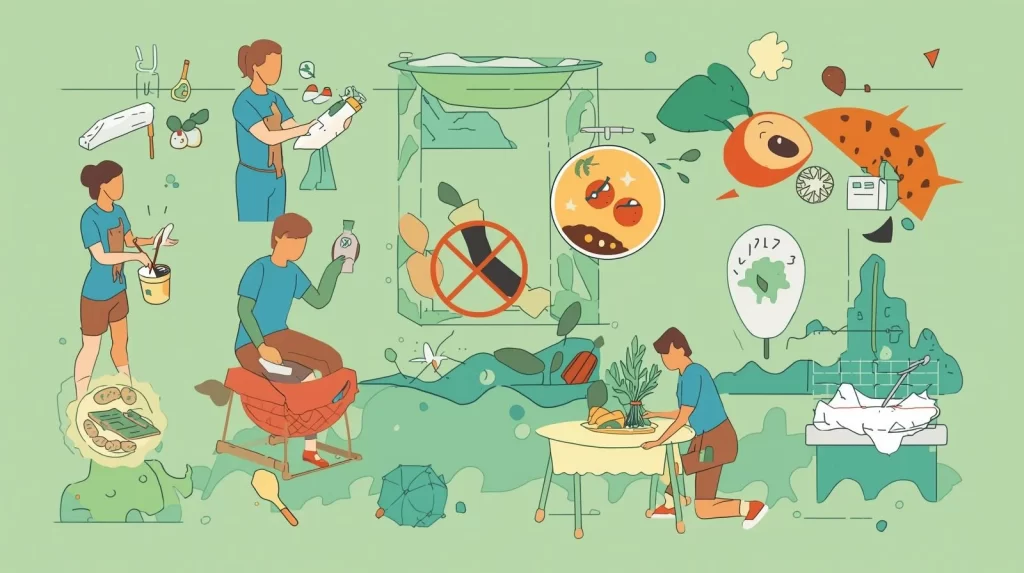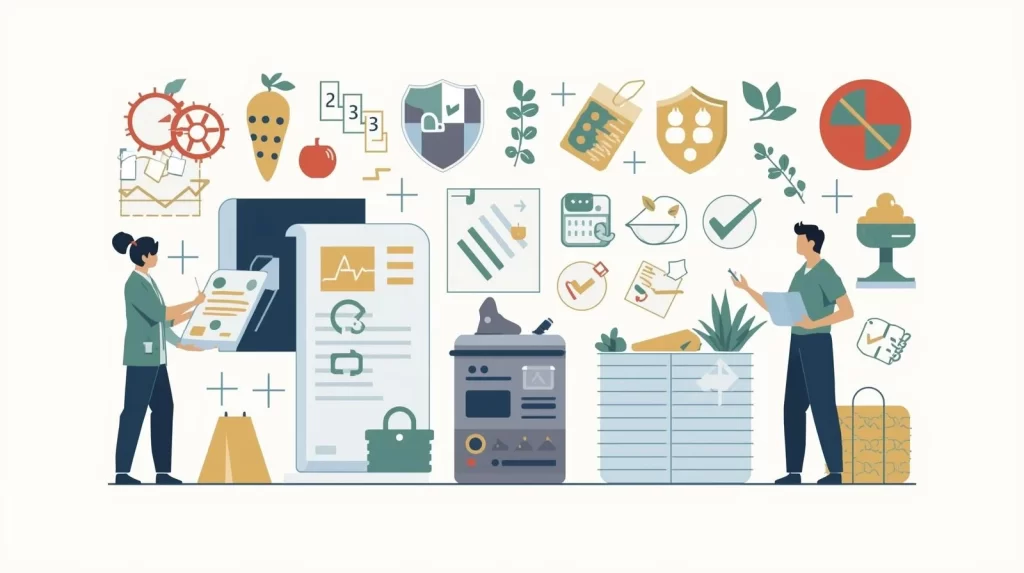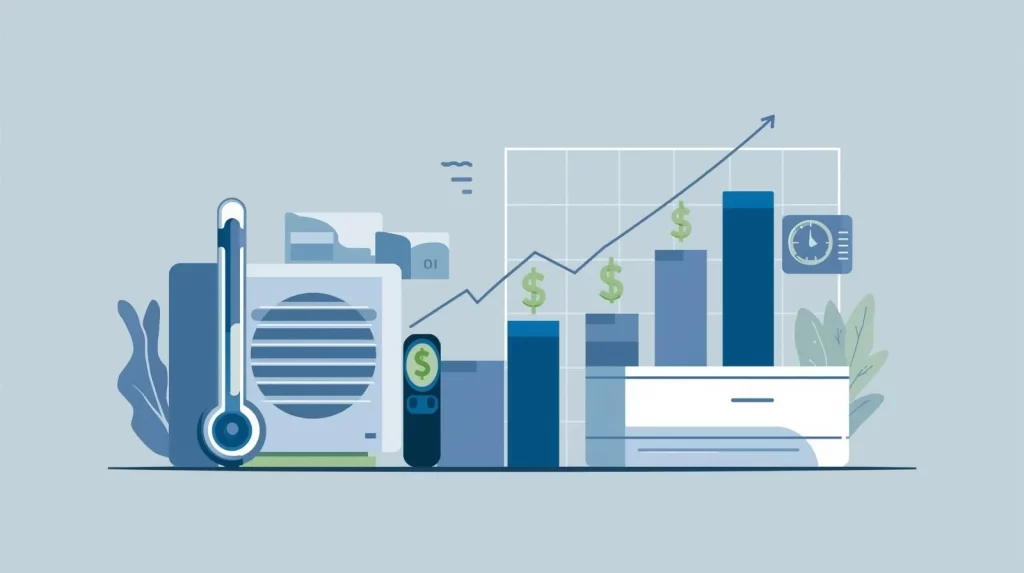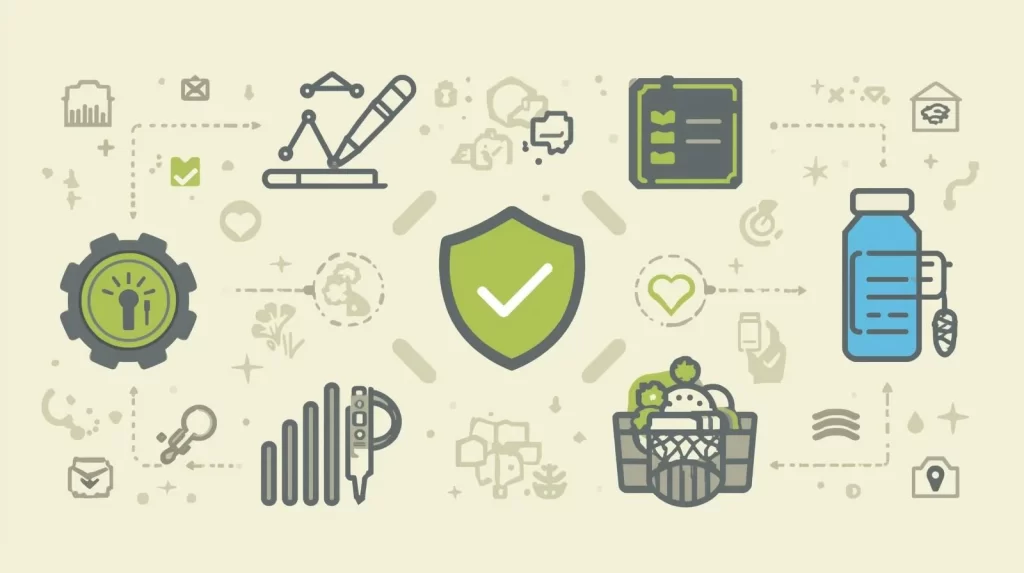Biological hazards are responsible for most of the 48 million reported cases of foodborne illnesses worldwide every year. Learning what makes food hazardous and how to control these risks is essential for every food handler. Food safety hazards can enter the food chain at any stage, making preventive controls an important necessity.
These practices are applicable not only in your restaurant or food processing facility, but also in your home kitchen, for the prevention of foodborne illnesses.
This guide reviews the various food hazards, most importantly, biological hazards in food. You will learn practical, evidence-based strategies to not only protect consumers but also maintain food safety management standards.
What is a Food Hazard?
A food hazard refers to any substance that can make your food unfit for human consumption. Food hazards refer to biological, chemical, physical, and allergenic threats that can cause health problems.
What is the food hazard definition in everyday terms? It’s everything that can cause injury, illness, or contamination in food products.
These hazards can be present at any point in the food supply chain, that is, from farm to table. The Food Standards Agency states that the process of recognizing and regulating food hazards is the most effective way to keep the public’s health safe.
Here are several factors that contribute to making food unsafe:
- Improper temperature control allows bacterial multiplication.
- Cross-contamination from raw to ready-to-eat foods.
- Food handlers who are poor in personal hygiene.
- Reheating processed foods and improper cooking.
- Contaminated water or ingredients.
- Chemical contaminants exposure or allergens.
The food industry is most concerned about biological hazards. These cause most foodborne illnesses and can lead to serious health risks, lawsuits, and damage to a company’s reputation.

What are the Types of Food Hazards?
Food hazards are classified into four primary categories, each with its own preventive and control measures. Understanding the various types of food hazards is essential for providing comprehensive food safety management systems.
1. Biological Hazards in Food
Biological hazards are microorganisms that produce toxins when ingested, causing gastrointestinal illnesses. The primary factor contributing to foodborne diseases is the presence of microbiological hazards in food.
The term “biological hazards” encompasses a wide range of bacteria, viruses, parasites, and fungi. They are highly adaptable and can often be found in various parts of the food chain.
Common biological hazards include:
- Bacteria: Salmonella, E. coli, Listeria, Campylobacter
- Viruses: Norovirus, Hepatitis A
- Parasites: Giardia, Toxoplasma, Trichinella
- Fungi: Molds producing harmful toxins
2. Chemical Food Safety Hazard
Chemical hazards may result from natural or human errors during the production and distribution of food. If they are not handled correctly, these can cause either acute poisoning or eventually lead to chronic health problems.
Chemical food safety hazards include:
- Pesticide residues from agricultural practices
- Improper use of food additives
- Food surfaces that are contaminated by food chemicals
- Heavy metals from environmental pollution, like lead and mercury
- Industrial contaminants from processing equipment
3. Physical Food Hazards
Physical food hazards refer to the presence of foreign objects that contaminate the food. These risks can lead to people getting injured, choking, or suffering from damaged teeth if they eat the affected items.
Common physical hazards include:
- Broken containers that have glass fragments
- Processing machinery that has metal shards
- Packaging materials that have plastic pieces
- The food handler’s hair, nails, or jewelry
- Bones, pits, or shells not properly removed
4. Allergenic Hazards in Food
Allergenic hazards refer to situations where allergens are present in foods that have not been labeled correctly. Such conditions can cause adverse reactions in people with food sensitivities, which can range in severity from mild discomfort to life-threatening anaphylaxis.
Nuts, dairy products, eggs, fish, shellfish, wheat, and soy are the most common allergens.
Understanding Biological Hazards: The Major Threat
Biological hazards are the main cause of disease or injury in the food service industry. Microorganisms and their toxins can be very dangerous, sometimes causing serious illnesses like gastroenteritis or even death.
Unlike chemical or physical hazards, biological hazards can multiply very quickly. If conditions are right, one bacterium can become millions in just a few hours. This makes them the biggest threat to food safety in a short time.
Food safety is a critical issue that not only prevents but also saves lives and protects businesses.
According to CDC reports, every year about 48 million Americans are infected with foodborne diseases. Of them, 128,000 need hospital treatment, and 3,000 die.
What are the 4 Types of Biological Hazards?
Every food handler must be aware of the four primary types of biological hazards: bacteria, viruses, parasites, and fungi.
Bacteria
Bacteria are single-celled microorganisms that can multiply rapidly when the right conditions are present. Some bacteria can survive tough environments by forming spores. Foodborne bacteria, such as Salmonella, E. coli O157:H7, Listeria monocytogenes, and Campylobacter, cause millions of infections each year.
Viruses
Viruses can survive in harsh conditions, such as high acidity and heat. They spread easily through contaminated water, food handlers, and raw fruits and vegetables. Norovirus and Hepatitis A are the most common foodborne viruses, causing stomach illness and liver inflammation.
Parasites
Parasites are organisms that live off a host. They can contract foodborne illnesses through contaminated water, soil, or food handled by infected individuals. Common foodborne parasites that cause stomach problems include Giardia, Cryptosporidium, and Toxoplasma.
Fungi
Fungi include molds and yeasts, and some species produce toxic substances. Once food is contaminated with these toxins, it is very hard to make it safe again. Aflatoxins, a type of toxic mold, can cause serious health issues, so prevention is key.
Why Microbiological Hazards in Food Are Dangerous
Microbiological hazards are responsible for annual economic losses of nearly 95.2 billion dollars in low- and middle-income countries. Their impacts vary from mild abdominal cramps to severe cases that involve dehydration, organ failure, and death.
The higher exposure risk is for vulnerable groups: pregnant women, toddlers, the elderly, and people with weakened immune systems. Acute foodborne biological hazards may result in hospitalization and chronic health issues for these groups. Uncontrolled epidemics can affect hundreds or thousands of people, causing loss and suffering among communities and businesses that are repeatedly impacted.
Which Food Safety Practices Prevent Biological Hazards?
Using several connected food safety procedures helps prevent biological hazards. When these steps are followed regularly, they create a strong barrier that keeps out contaminants and bacteria.
- Proper Handwashing Techniques
Handwashing is the best way to remove biological hazards. The CDC says that proper handwashing can prevent half of all infections and deaths from diarrheal diseases.
Follow these handwashing steps:
- Wet your hands with warm or cold water
- Apply soap to your hands thoroughly for at least 20 seconds
- Scrub all surfaces of your hands thoroughly, including the backs of your hands, between fingers, and under nails
- Under running water, rinse your hands completely
- Dry your hands with single-use paper towels or an air dryer
- Temperature Control and Proper Cooking
Cooking food to the right internal temperature kills harmful bacteria and helps prevent foodborne illnesses. Throughout every step, from receiving to serving, temperature control is the key factor.
The temperature danger zone is 40°F to 140°F (4°C to 60°C). In this range, bacteria multiply quickly, doubling every 20 minutes. Keep hot foods above 140°F (60°C) and cold foods below 40°F (4°C).
Here are the temperatures of safe minimum internal cooking:
Food Safety Cooking Temperatures
| Food Item | Minimum Internal Temperature |
|---|---|
| Poultry (chicken, turkey, duck) | 165°F (74°C) |
| Ground meats (beef, pork, lamb) | 160°F (71°C) |
| Beef, pork, lamb steaks/roasts | 145°F (63°C) + 3 min rest |
| Fish and seafood | 145°F (63°C) |
| Eggs and egg dishes | 160°F (71°C) or until firm |
| Leftovers and casseroles | 165°F (74°C) |
| Hot holding temperature | 140°F (60°C) or above |
| Cold holding temperature | 40°F (4°C) or below |
Always check internal temperatures with a food thermometer. Do not rely on color or texture alone to judge the safety of food. For optimal results, insert the thermometer into the thickest part of the meat, avoiding areas near bones.
It is also important to cool cooked food properly. Cool food from 140°F to 70°F (60°C to 21°C) within 2 hours, then from 70°F to 40°F (21°C to 4°C) within the next 4 hours. Use shallow containers, ice baths, or cooling paddles to speed up cooling.
- Preventing cross-contamination
Cross-contamination happens when harmful bacteria transfer from one food item to another through direct contact or by contaminating the surfaces they have been on. Therefore, halting this transfer is crucial to ensure the safety of the food.
Strategies for preventing cross-contamination:
- Utilize different cutting boards for raw meat and ready-to-eat foods
- Implement colored cutting boards (red for raw meat, yellow for poultry, blue for seafood, green for vegetables)
- Place raw meat on the bottom shelf of the refrigerator to prevent damage from leaks.
- Do not serve cooked food in dishes used for raw meat
- Have distinct tools and equipment for raw and cooked food
- Sanitize every area used for different food preparations after cleaning it up
- Rinse vegetables very well under running water before cutting them
- Always keep raw and cooked food apart from each other during both storage and preparation
The color-coding system makes it possible for chefs and other kitchen personnel to easily recognize the different utensils applicable to various types of food.
- Cleaning and Sanitization
Both cleaning and sanitizing eliminate biological hazards from food-contact surfaces, equipment, and utensils. These procedures differ, and although they are closely related, they serve distinct purposes.
Cleaning is the process of removing, with detergents and warm water, all the visible dirt, food, and grease. On the other hand, sanitizing is the process of killing bacteria and microorganisms to safe levels through the use of heat or chemical sanitizers.
Process for cleaning kitchen surfaces:
- Remove food debris by scraping and wiping surfaces
- Apply appropriate cleaning detergent to remove grease and particles
- Scrub all surfaces thoroughly, focusing on high-use areas
- Rinse with hot water to remove all detergent residue
- Apply food-safe disinfectant according to manufacturer instructions
- Allow surfaces to air-dry completely or use clean towels
The “Clean As You Go” policy ensures food safety throughout the service. This approach emphasizes cleaning throughout the cooking process, rather than just at the end of the shift.
- Proper Food Storage
Proper storage of food prevents the growth of bacteria and maintains the food’s freshness. One of the critical factors in safe storage is temperature control, which helps prevent the growth of microorganisms that cause spoilage and foodborne illnesses to dangerous levels for humans.
Practices for essential food storage:
- Refrigerator temperature at 40°F (4°C) or below should be maintained
- Freezer temperature at 0°F (-18°C) or below should be kept
- Cover stored foods in airtight containers to prevent contamination
- All foods should be labeled with preparation dates and use-by dates
- Follow the “First In, First Out” (FIFO) rotation method
- Never overload freezers or refrigerators; these raise internal temperatures
- Raw meats, poultry, seafood, and below-ready-to-eat foods should be stored
- Separates raw and cooked foods at all times
- Discard foods left in the danger zone for more than 4 hours
The entire food service operation is affected by water contamination. Make a habit of regularly performing microbiological analyses on water used for washing and cooking.
- Personal Hygiene for Food Handlers
The quickest route for biological hazards to get into food in a commercial setting is through food handlers. By maintaining the highest level of personal hygiene, it is possible to prevent the contamination of food from people.
Requirements for critical personal hygiene:
- Always wear clean and safe clothing that is suitable for the task, and change them if they get dirty
- Long hair must be tied, and hair nets or hats should be worn
- Fingernails should be short, clean, and without any polish
- Only plain wedding bands should be worn; all other types of jewelry should be removed
- Cuts and wounds should be covered with waterproof bandages and gloves
- Do not touch your face, hair, or body while handling food
- Coughing, sneezing, or spitting near food or preparation areas is not allowed
- Eating, drinking, smoking, or chewing gum is strictly prohibited in food preparation areas
- Illness should be reported, especially foodborne disease symptoms
- If you are experiencing symptoms such as vomiting, diarrhea, or respiratory illness, it is recommended that you stay at home.
Food handlers who are suffering from contagious diseases are capable of contaminating a huge amount of food. Workers who exhibit symptoms such as diarrhea, vomiting, a sore throat with fever, or jaundice should not be allowed to work with food.
Food Safety Management Systems
The implementation of food safety management systems provides a structured approach to dealing with biological hazards. These systems not only react but also prevent the problems in a proactive way.
What is HACCP?
HACCP stands for Hazard Analysis and Critical Control Points. This method, now used around the world, helps identify, control, and manage the main hazards in food production. These hazards can be biological, chemical, or physical in nature.
HACCP originated in the 1960s when NASA and Pillsbury collaborated to ensure the safety of food for astronauts. Today, it is the global standard for food safety and is required by many regulators and certification programs. The system focuses on preventing problems instead of just checking finished products.
The seven HACCP principles are:
1. Identifying potential hazards by conducting hazard analysis
2. Determine Critical Control Points (CCPs) where hazards can be prevented
3. Establish critical limits for each CCP
4. Establish monitoring procedures for CCPs
5. Establish corrective actions when limits are exceeded
6 Establish verification procedures to ensure system effectiveness
7 Establish record-keeping and documentation procedures
How HACCP Controls Biological Hazards
HACCP identifies steps in food processing where biological risks can be controlled. For example, cooking is a Critical Control Point because it kills harmful bacteria in raw meat.
Risk assessment evaluates the likelihood of each biological hazard causing harm. The most serious risks become Critical Control Points and are closely monitored. This risk-based approach helps focus resources on the most important food safety concerns.
Monitoring ensures that critical limits are always adhered to. If something goes wrong, corrective actions are taken immediately to prevent unsafe food from reaching consumers.
Conclusion
To prevent biological hazards, always follow key food safety steps. Wash your hands, control temperatures, avoid cross-contamination, clean thoroughly, store food properly, and maintain good personal hygiene.
Understanding what makes food unsafe helps food handlers prevent problems. Most foodborne illnesses come from biological hazards, but you can manage these risks with simple, science-based steps. Implement these safety practices daily and ensure they are consistently followed.
Ensure you have the right equipment, train your team, and implement a food safety management system. Stay up-to-date with new practices and regulations. When we work together, we can minimize biological risks and ensure food safety for everyone.
Everyone in the food industry shares responsibility for food safety. It is important to always follow established safety procedures.
For complete food safety solutions and training, contact us at Jadian.
FAQs
What food safety habit would eliminate biological hazards in the most efficient way?
Washing your hands properly is the best way to prevent biological hazards. Regular handwashing can reduce the risk of foodborne illness by up to 50%. For full safety, combine good hygiene with temperature control and preventing cross-contamination.
What temperature kills bacteria in food?
Cooking food to 165°F (74°C) kills most harmful bacteria. Each food has its own safe minimum: 165°F for poultry, 160°F for ground meats, and 145°F with a 3-minute rest for whole cuts of beef, pork, and lamb. Always use a food thermometer to check.
How long can food stay in the danger zone?
Food should not stay in the temperature danger zone (40°F-140°F or 4°C-60°C) for more than four hours total. For high-risk foods, try to keep them under two hours. In this range, bacteria can double every 20 minutes, so timing is key for safety.
What are the 4 types of biological hazards in food?
The four types of biological hazards are bacteria, viruses, parasites, and fungi. Bacteria like Salmonella and E. coli cause many foodborne illnesses. Viruses such as Norovirus often spread through contaminated water or food handlers. Parasites and fungi are less common but can still cause serious health problems.
Why is preventing cross-contamination important?
Cross-contamination enables the movement of pathogenic microorganisms from unprocessed to processed items, which results in the consumption of unsafe food. If raw and cooked food are kept in separate places, with different utensils and cutting boards, this migration does not happen.
How does HACCP help prevent biological hazards?
HACCP identifies key steps, called Critical Control Points, where you can prevent, remove, or reduce biological hazards. It also outlines how to monitor these points and the limits to follow.
What personal hygiene practices prevent foodborne illness?
Good personal hygiene involves washing your hands frequently, wearing clean protective clothing, covering your hair, keeping your nails short and clean, and covering any wounds. Food handlers should avoid touching their face or hair while working.
What makes microbiological hazards so dangerous?
You can’t see microbiological hazards without testing, so they are hard to spot. They grow quickly in the right conditions, which can make food unsafe fast.






